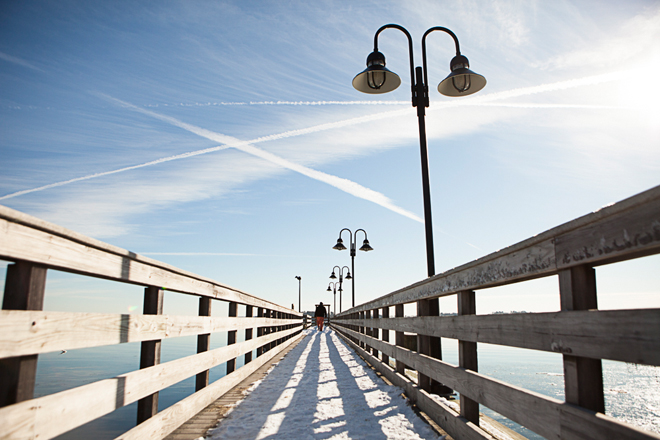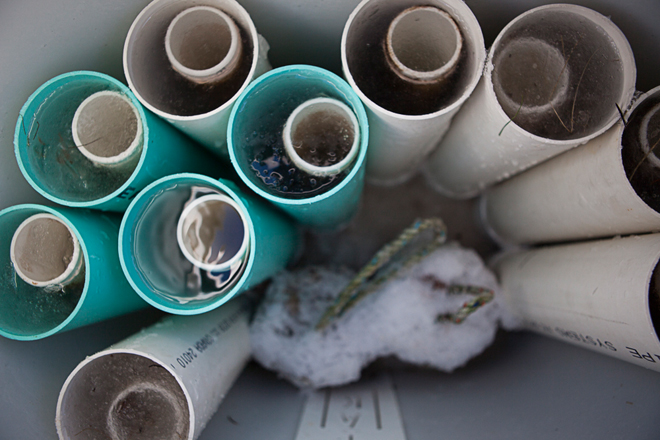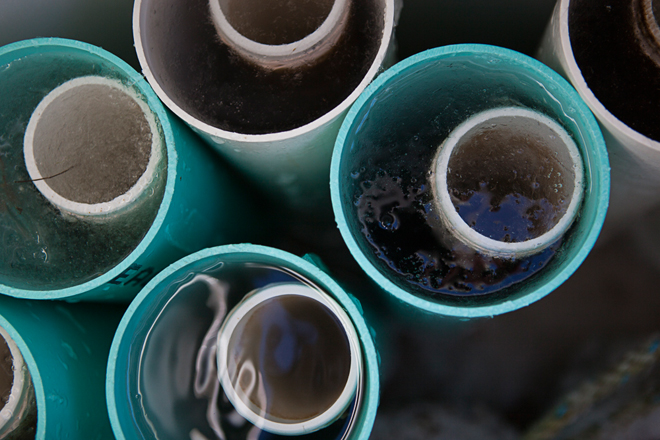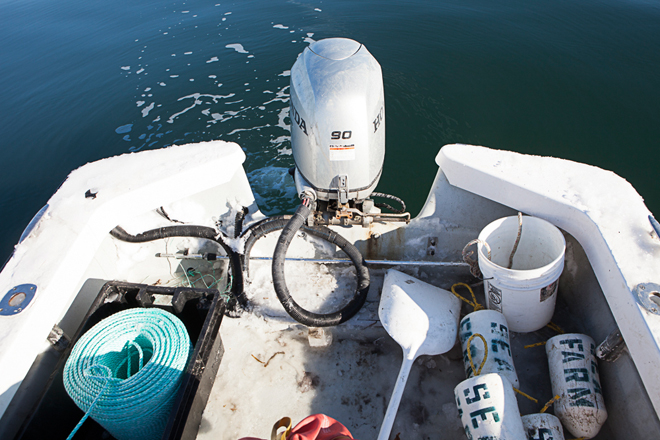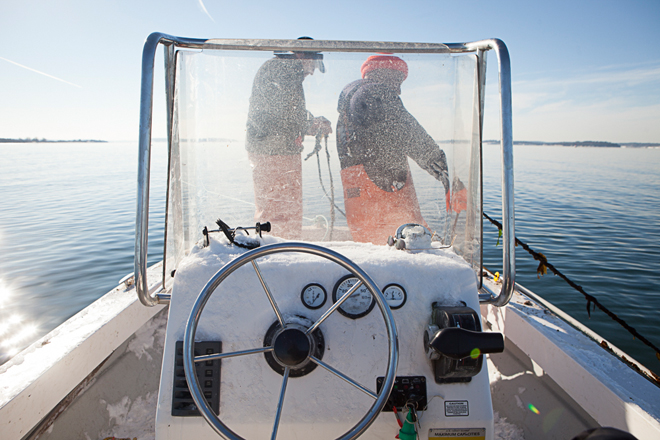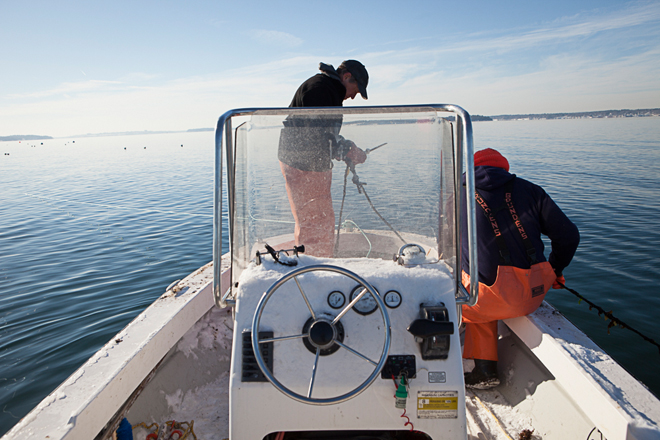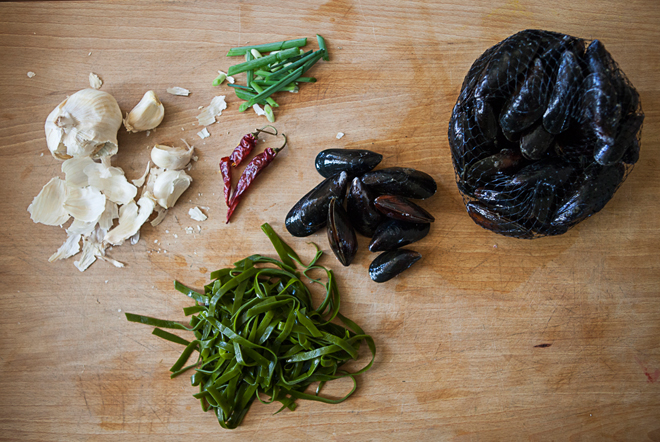Tollef Olson on kelp farming
PROFILE-March 2014
By Susan Conley
Photographs by Greta Rybus
Tollef Olson explains his mission to bring the healthiest vegetable you can eat to tables and palates around America
Long before Tollef Olson founded Ocean Approved, his Maine-based kelp company, in 2006, he was patiently waiting for kelp’s breakout moment on the American food market. It took thirty long years. What Olson, a Maine native and serious foodie, did in the meantime was to circle the world’s oceans: fishing for hire, salvaging shipwrecks, and chasing down big waves. Kelp was always on his mind. He knew that most of Maine’s indigenous coastal peoples had used kelp as a food staple in past centuries and that it was delicious when married with local shellfish and vegetables. Now at long last, and with a lot of help from Olson, kelp is having another moment on the culinary stage.
We’re standing in Olson’s kitchen on Willard Beach in South Portland, where I’ve been invited to a kelp tasting: kelp bruschetta, crab salad with kelp and baby herbs, and Bang Island mussels with kelp noodles. Olson starts by giving me the good news of the day: one serving of kelp is like eating a multivitamin with heaps of extra fiber. Kelp is also full of iodine (the good, natural kind) and potassium, plus magnesium, and iron, and it beats out a glass of milk for calcium. “It’s the healthiest vegetable you can eat,” he says with one of his easy grins.
Question: what is kelp really?
Answer: a sea vegetable that lives in the family of brown algae.
Who wants to order brown algae off the menu, Olson asks. Or even seaweed? “People cringe,” he, says, “when they hear the word ‘weed’ in their food, so the market has evolved into using the catch-all name, kelp.”
In 1990, Olson returned to Maine after treasure hunting on boats all over the world and jumped into the sea urchin industry. Every time he carried urchins up from the sea floor, he also brought up a little kelp and told the boat hands not to throw it away because he was going to cook it for dinner. Olson had a ringside seat when Maine’s urchin fishery collapsed. He pushed for legislation on catch limits, but it was too little too late. “I’ve seen too many fisheries implode in my lifetime,” he says. Kelp is his chance to finally help write a fishery story with a very different ending.
“It’s 100 percent sustainable: kelp needs no arable land. No fertilizer. No fresh water.”
It eats carbon dioxide for breakfast and combats ocean acidification by releasing oxygen back into the sea, all part of why Olson believes that kelp is going to change the way people eat all over the world.
When Paul Dobbins joined Ocean Approved in 2009, he brought a love of the ocean and a strong business background with him. Together he and Olson began five years of rigorous research and development around how to sustainably farm their kelp and take it to market. “We have now entered the decade of food,” Dobbins told me when we sat down to talk about kelp’s role in the larger food chain. “People care about where it comes from. They want it sourced from sustainable, local industries. And they’ll seek those sources out.”
Here’s how Olson could tell that the American food market was really ready for his kelp: people started eating healthier across the country. They began calling for responsible food, and they asked for food that was ecologically viable. It marked the dawning of what Olson calls the kelp era. He began experimenting with farming kelp back in 2002 by leaving his lobster traps in all winter at Simonton Cove down the hill from his house. He attached some baby kelp to the traps, and the kelp did well. Then Olson knew that he could slowly move away from wild harvesting and get into kelp cultivation. Ocean Approved operates the very first kelp food farm in the United States. Olson and Dobbins nurture microscopic kelp spores in their laboratory in Portland and then grow them into adult plants at ocean farms they maintain off islands like Little Chebeague, Chebeague, and Jewel.
Kelp isn’t a true root vegetable, so it doesn’t affix itself to the ocean floor unless it absolutely has to. It likes to grow up on top of something—a mussel bed, or a buoy line, and it feeds through the wider, leafier sections of its body, called blades. During their research and long hours spent in wetsuits studying the kelp in situ, Olson and Dobbins learned that the plants prefer to lie horizontally in the water column, not vertically, to absorb all the sunlight they can.
“The benefits of aquaculture,” Olson says, “are that we see where the kelp really likes to be. And when we farm it, we can put it in the environment it most prefers and take pressure off the natural beds.”
The vast majority of kelp sold in the world is dried, and this drying process intensifies the plant’s flavors and limits its versatility. Ocean Approved has taken the drying step out. They freeze their kelp after boiling it, and the result, Olson attests, is a product that he can’t ever tell has been frozen. Freezing maintains the kelp’s mild flavor and its natural green color. “I’ve done taste tests with kelp I’ve had in the freezer for six years,” Olson says, “and there’s no different between it and what I harvested last week.”
He’d like to gently nudge the American palate away from the assumption that kelp “is only meant for a seaweed salad at the Japanese restaurant.”
He and Dobbins have curated three different lines of kelp. The first is called “Kelp Slaw Cut,” and it’s produced from fresh Laminaria digitata kelp, or what Olson calls “horse tail.” He describes it as “crunchy and mild flavored kelp.” This is the seaweed you may have seen on top of one of those incredible salads at Flatbread Pizza in Portland.
“Kelp Salad Cut” is produced from fresh alaria, or “winged kelp.” Olson says it has a slight walnut flavor. He likes alaria in salads, soups and even cookies. The kelp noodles we’re having with our mussels today come from fresh Saccharina latissima, or “sugar kelp.” When I reach for one in the bowl by the stove and take a bite, it has a fresh, mild, slightly salty flavor that makes me think of the ocean.
The farms and processing plant at Ocean Approved employ dozens of different people on a year-round and seasonal calendar. Olson and Dobbins both see kelp as a “huge incubator for the state” in terms of jobs. As their company moves out of its start-up phase and becomes a teenager its eyes are trained on the restaurant industry. You can already see Ocean Approved kelp in guest-appearances at Portland eateries like Grace and Miyake and at a handful of other restaurants up and down Maine’s coast.
Olson has a personal goal to see how many different dishes he can cook with kelp. This means kelp for breakfast in the smoothies he makes for his family, scallops wrapped in kelp for dinner, and each dish in our three-course lunch, which is almost ready now. The mussels have been cooked in a skillet with olive oil, butter and garlic. Then Olson threw in some chopped chives. When the purple shells opened, he mixed in the dark green kelp noodles. My first bite made me think of spinach with a bit of salt. It was a mild, pleasing taste. To finish off the bruschetta, Olson took a handful of kelp stines— small round pieces of sliced kelp stem, no bigger than dimes. He mixed the stines in with chopped tomato, garlic and olive oil and spooned it on top of slices of French bread. I’m not sure which I like more, the bruschetta or the mussels. Both are really tasty. Then we move on to the crab with kelp, which Olson dressed in olive oil and a splash of vinegar. Mouth watering.
Olson takes a bite, then turns to me with another one of his infectious smiles and says, “The kelp market has finally arrived.”
188 Presumpscot Street | Portland | 207.671.7946 | oceanapproved.com



















